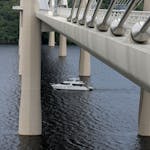The Ramsey County Board approved a nearly $16 million plan to build a series of wildlife-nurturing islands in Pigs Eye Lake in St. Paul, using dredge material excavated from the Mississippi River.
The goal is to create more natural habitat in and around the lake, which is a backwater of the Mississippi River. Ramsey County owns more than 500 acres of property surrounding much of the lake, which is considered parkland but is largely undeveloped.
Plans call for the construction of a half-dozen islands in the more than 600-acre lake. The project — a partnership between the county and the Army Corps of Engineers — has garnered both praise and criticism from some nearby residents who question the use of dredge material and worry about existing pollution near the site. A large Superfund site, the old Pig's Eye Dump, is located near the lake.
Before the unanimous County Board vote Tuesday, commissioners said they've studied the issue, conferred with staff and listened to public comments.
"I do fully support this project," said Commissioner Jim McDonough, who represents the East Side of St. Paul. "I am looking forward to this investment and seeing this occur."
Commissioner Victoria Reinhardt addressed critics directly, some of whom have accused county officials of not listening to their viewpoints.
"We do understand this is sensitive. It's about the environment," Reinhardt said. "This isn't something any of us are taking lightly, but just because we didn't agree [with the critics] doesn't mean we weren't listening."
One vocal opponent and East Side resident, Tom Dimond, has persistently lobbied against building the islands, arguing at one point that "the first priority should be pollution cleanup." St. Paul City Council Member Jane Prince, whose ward includes part of the East Side, said in a statement that she has been vocal about the need for more public input.
"Keep in mind that this once beautiful part of the Mississippi River was turned into a dump, and became a Superfund site because of the same disregard for lower-income and BIPOC [Black, Indigenous, people of color] neighbors on the East Side," she said.
St. Paul's Parks and Recreation Department has thrown support behind the project, but officials said they want long-term monitoring of the islands.
"We share the mission of protecting, restoring and enhancing habitat along the Mississippi River," said department spokeswoman Clare Cloyd. "Vegetation establishment and stability of the constructed islands are both critical to the success of creating habitat and island stabilization, and we are hopeful that these concerns will be addressed in the 10-year monitoring and adaptive management period proposed by the U.S. Corps."
Ramsey County park staffers have compared the shallow waters of Pigs Eye Lake to an aquatic desert. Wind sweeping across the lake stirs sediment in the water, blocking sunlight and preventing vegetation from taking root.
The islands would help block winds, lower sediment and create habitat for native plants and animals including fish, frogs, waterfowl and river otters.
Ramsey County Natural Resources Director Mike Goodnature has called it the county's largest water restoration project. Officials with the Friends of the Mississippi River have expressed optimism.
The Corps, which has spent years conducting soil and water tests, would use dredge material removed from the river channel to build the islands. They've already built dozens of habitat islands up and down the Mississippi and have seen those islands flourish with wildlife, said Nathan Campbell, project manager for the Army Corps' St. Paul District, during a tour of Pigs Eye in 2019.
"The dredge material was tested by the Minnesota Pollution Control Agency and was determined suitable for placing in public waters," said Scott Yonke, planning and development director for Ramsey County Parks and Recreation, in an earlier video detailing the project.
Funding is coming from federal and state agencies including the Lessard-Sams Outdoor Heritage Council. Construction is likely to begin in July.
"The early summer start date allows for greater sensitivity to aquatic spawning and migratory wildlife nesting seasons," said Kristina Saksvig, a Ramsey County spokeswoman.
Shannon Prather • 651-925-5037





